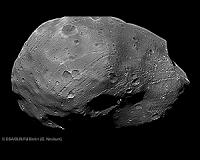 |
Paris, France (ESA) Feb 03, 2011 The first full-duration simulation of a manned voyage to Mars has reached a major milestone: the 'spacecraft' yesterday 'arrived' at Mars after 244 days of virtual interplanetary flight. Three crewmembers will 'land' on Mars on 12 February and make three sorties onto simulated martian terrain. Mars500, a pioneering international study of the complex psychological and technical issues that must be tackled for long spaceflights, has been running for more than eight months in hermetically sealed modules imitating a Mars spacecraft at the Institute of Biomedical Problems (IBMP) in Moscow. The crew of three Russians, two Europeans and one Chinese has been living and working in the facility like a real expedition to Mars. They are following a similar seven-day week, with two days off duty, to the astronauts on the International Space Station. Their work time during the 'flight' is filled with maintenance jobs, experiments and daily exercise. "Mars500 is a visionary experiment," notes Simonetta Di Pippo, ESA Director for Human Spaceflight. "Europe is getting ready to make a step further in space exploration: our technology and our science grow stronger every day. "Mars 500 today is only an enriching simulation, but we are working to make it real."
Mars now - but virtually The final approach began on 24 December by shifting their imagined trajectory from interplanetary space to a spiral orbit leading down to the vicinity of the Red Planet. The crew opened the hatch between the mothership and the mockup of a lander that, according to script, was launched separately to Mars. In the coming days, the cargo inside the 'lander' will be transferred into the habitat and the lander will be prepared for 'undocking' and 'landing'. The crew will then divide: Russian Alexandr Smoleevskiy, Italian Diego Urbina and Chinese Wang Yue will enter the lander, while the rest of the crew, Romain Charles from France and Sukhrob Kamolov and Alexey Sitev from Russia 'remain in orbit'. The hatch between the interplanetary spacecraft and lander will be closed on 8 February. The lander will undock and 'touch down' on Mars on 12 February.
Going out The next sortie - by Smoleevskiy and Wang Yue - will take place on 18 February, and the last one - by Smoleevskiy and Urbina - is scheduled for 22 February. On 23 February, the lander will be launched to 'orbit' and dock with the mothership on following day. The lander crew will stay in quarantine for three days before the hatch is opened on 27 February and the astronauts are reunited.
Still more than 200 days to go After that, the crew is faced with another monotonous 'interplanetary cruise' before arriving home in early November 2011.
Share This Article With Planet Earth
Related Links Mars500 Mars News and Information at MarsDaily.com Lunar Dreams and more
 The Southern Hemisphere Of Phobos, Up Close
The Southern Hemisphere Of Phobos, Up CloseBonn, Germany (SPX) Jan 24, 2011 During the last of a series of eight encounters with the martian moon Phobos, the High-Resolution Stereo Camera (HRSC) on ESA's Mars Express spacecraft acquired a detailed view of the martian satellite. The orbiter flew past Phobos at a distance of only 100 kilometres on 9 January 2011 and imaged the southern hemisphere of the irregularly-shaped moon. Researchers at the German Aerospace Ce ... read more |
|
| The content herein, unless otherwise known to be public domain, are Copyright 1995-2010 - SpaceDaily. AFP and UPI Wire Stories are copyright Agence France-Presse and United Press International. ESA Portal Reports are copyright European Space Agency. All NASA sourced material is public domain. Additional copyrights may apply in whole or part to other bona fide parties. Advertising does not imply endorsement,agreement or approval of any opinions, statements or information provided by SpaceDaily on any Web page published or hosted by SpaceDaily. Privacy Statement |